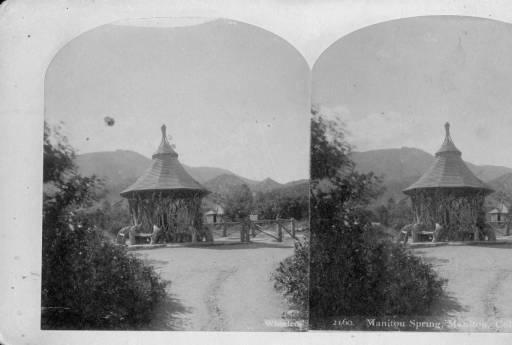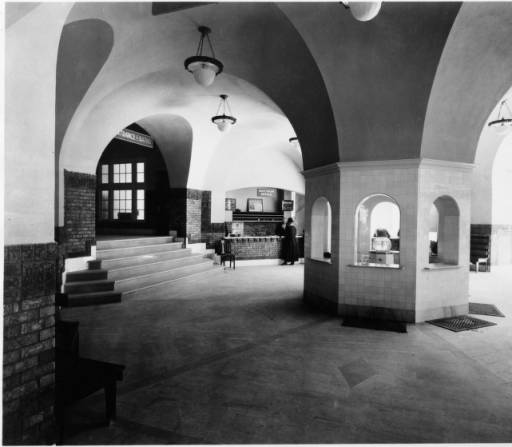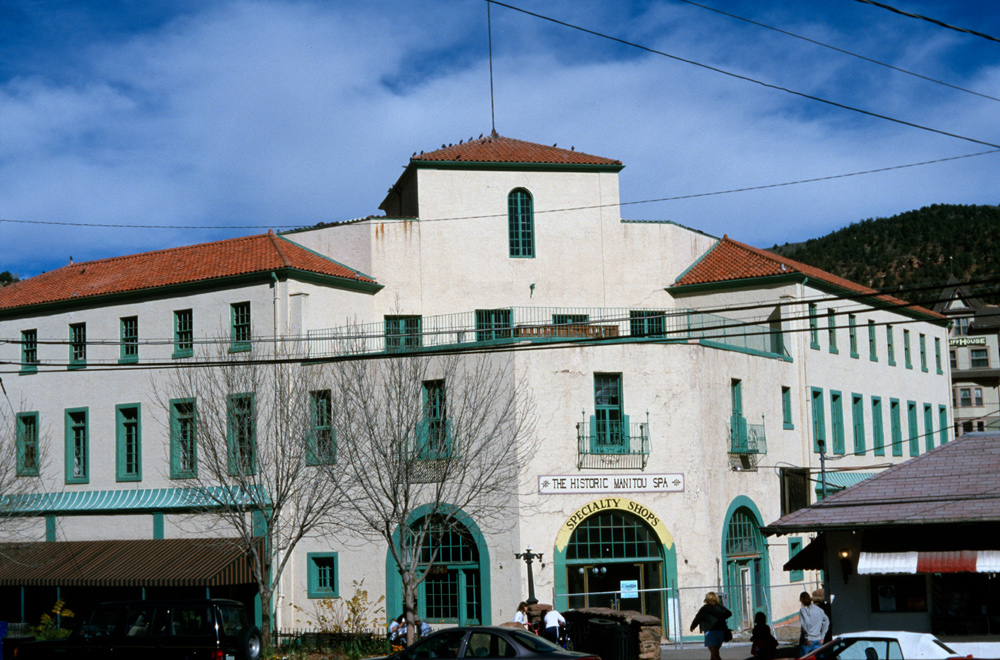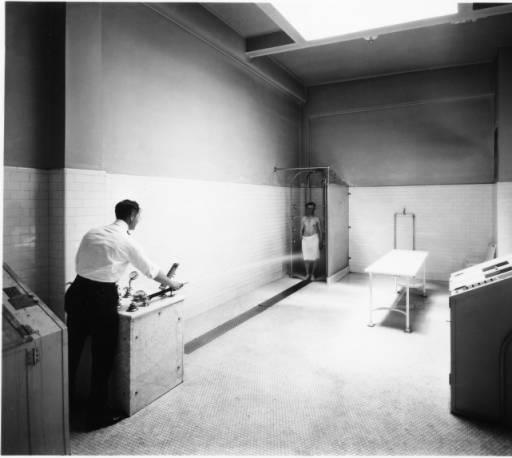Manitou Springs Spa Building
Full Article
The Manitou Springs Spa Building stands on top of Soda (or Manitou) Spring on the north bank of Fountain Creek in downtown Manitou Springs. The three-story Spanish Colonial Revival building was built in 1920 to help revive Manitou’s sagging health tourism industry by offering modern mineral water treatments. In the late twentieth century, the building was converted to a mix of commercial and residential uses. It gradually deteriorated before it was rehabilitated in the early 2000s to house shops, restaurants, and condominiums.
Early Manitou Bathhouses
 Soda Spring is one of several springs that sit at the base of the old hunting trail over Ute Pass and were used by Native Americans for religious and medicinal purposes. In 1871 William Jackson Palmer and William Bell began to develop the area as a health resort. Their Colorado Springs Company hired Chicago landscape architect John Blair to design the town of Manitou Springs, which would feature elegant bathhouses, parks, and paths near the springs. The town’s first hotel, the Manitou House, opened in 1872, the same year that a rustic log pavilion with seating was built near Soda Spring.
Soda Spring is one of several springs that sit at the base of the old hunting trail over Ute Pass and were used by Native Americans for religious and medicinal purposes. In 1871 William Jackson Palmer and William Bell began to develop the area as a health resort. Their Colorado Springs Company hired Chicago landscape architect John Blair to design the town of Manitou Springs, which would feature elegant bathhouses, parks, and paths near the springs. The town’s first hotel, the Manitou House, opened in 1872, the same year that a rustic log pavilion with seating was built near Soda Spring.
The Panic of 1873 slowed development in Manitou, but by 1880 the construction of a new railroad spur from Colorado Springs brought an influx of new visitors and investors. Large new hotels such as the Cliff House helped make Manitou one of the most popular summer resorts in the West. Hordes of health seekers suffering from tuberculosis and other maladies came to reap the supposed benefits of mountain air and mineral water. In 1885 the original rustic pavilion at Soda Spring was replaced by a much larger Victorian building that cost $3,500 and featured a lemonade stand. Soon a decorative iron fence encircled the area to prevent free use of the spring water.
The Spa Building
In the early twentieth century, health tourism to Manitou Springs started to decline. The town faced increasing competition from other resorts—including Colorado Springs, which became the area’s main center for tuberculosis treatment—while the use of mineral springs for health purposes faded as new treatments such as drugs, vitamins, and minerals began to take hold.
 The Manitou Springs Spa Building was designed to arrest this decline in tourism by offering a new, modern health facility at Soda Spring. The old Victorian building with the lemonade stand was torn down to make way for the new spa, which was completed in 1920. The three-story building in the Spanish Colonial Revival style featured stucco walls and a red tile roof. Its construction was supervised by John Fordyce, an expert on bathhouse design. The first floor had small shops and a fountain fed by Soda Spring in the middle of a rotunda. The second floor had baths and treatment rooms and the third floor offered overnight accommodations for guests.
The Manitou Springs Spa Building was designed to arrest this decline in tourism by offering a new, modern health facility at Soda Spring. The old Victorian building with the lemonade stand was torn down to make way for the new spa, which was completed in 1920. The three-story building in the Spanish Colonial Revival style featured stucco walls and a red tile roof. Its construction was supervised by John Fordyce, an expert on bathhouse design. The first floor had small shops and a fountain fed by Soda Spring in the middle of a rotunda. The second floor had baths and treatment rooms and the third floor offered overnight accommodations for guests.
The Manitou Springs Spa was the town’s last attempt to market mineral baths as a commercial venture. In the middle of the twentieth century, tourism to Manitou Springs was transformed by the rise of the automobile. Motels sprouted on the town’s eastern edge, and most of the large old resorts downtown were demolished because no one came to the mineral springs anymore. At some point the spa building stopped being used as a bathhouse. In 1963 the building’s third floor was converted into small apartments. The second floor was also used at times for residences, while the first floor remained commercial. In 1979 the building was listed on the National Register of Historic Places.
Rehabilitation
 The spa building was not well maintained in the late twentieth century, and by 1999 it was in such a state of deterioration that it had to be vacated. Soon after that, Fountain Creek flooded, washing several feet of water, rocks, and other debris through the building’s first floor. The owner could not sell the building, which was in such bad shape that Manitou Springs was threatening to condemn and demolish it. In 2000 the nonprofit Colorado Preservation Inc. named it one of the state’s most endangered places to spur efforts to save it. The building was also made part of the National Trust for Historic Preservation Save America’s Treasures program.
The spa building was not well maintained in the late twentieth century, and by 1999 it was in such a state of deterioration that it had to be vacated. Soon after that, Fountain Creek flooded, washing several feet of water, rocks, and other debris through the building’s first floor. The owner could not sell the building, which was in such bad shape that Manitou Springs was threatening to condemn and demolish it. In 2000 the nonprofit Colorado Preservation Inc. named it one of the state’s most endangered places to spur efforts to save it. The building was also made part of the National Trust for Historic Preservation Save America’s Treasures program.
Over the next few years, Colorado Preservation helped show that the building could still be saved and adapted to new uses, especially with Manitou Springs experiencing a surge of new full-time residents. Potential buyers gradually emerged, and in 2005 the building was sold to development partners who wanted to pursue a rehabilitation project. Today the renovated building houses shops and restaurants on the ground floor and condominiums on the upper floors.











